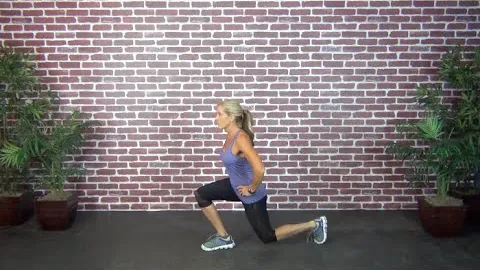
Do you want to take your leg training to the next level? Are you looking for a comprehensive exercise that targets multiple muscle groups in your lower body? Look no further than the lunge kick exercise. This compound movement not only builds leg strength but also helps improve your balance and coordination. In this article, we will dive deep into the benefits of the lunge kick exercise and provide instructions on how to perform it correctly. So, let's kick-start your leg training session with this powerful exercise.
The lunge kick exercise is a fantastic exercise that engages various muscle groups in your lower body, including your quadriceps, hamstrings, glutes, and calves. By incorporating this exercise into your training routine, you can reap numerous benefits, such as:
Leg Strength: The lunge kick primarily targets your quadriceps and hamstrings, helping you develop strength and power in these major muscle groups. Strong legs are essential for performing daily activities and sports-related movements.
Balance and Stability: The lunge kick exercise requires you to maintain proper balance and stability throughout the movement. This, in turn, strengthens your core and improves your overall balance and coordination, leading to better performance in other activities.
Functional Fitness: The lunge kick exercise closely mimics several functional movements, such as walking, running, and climbing stairs. By training with this exercise, you can improve your strength and endurance for everyday activities.
Muscle Imbalance Correction: Many people have muscle imbalances due to sedentary lifestyles, improper training techniques, or injuries. The lunge kick exercise targets and corrects these imbalances by working the muscles on both sides of your body equally.
Flexibility Enhancement: Performing lunges requires a good range of motion in your hip flexors, hamstrings, and calves. By regularly practicing the lunge kick exercise, you can enhance your flexibility and reduce the risk of injuries.
Now that you understand the benefits of the lunge kick exercise, let's dive into the proper technique for performing it:
Starting Position: Stand with your feet shoulder-width apart and your hands on your hips or extended in front of you for balance.
Step Forward: Take a big step forward with your right foot, ensuring that your heel hits the ground first. Your right knee should be directly above your ankle, forming a 90-degree angle.
Kicking Motion: Push off with your right foot and kick your left leg straight forward, keeping it parallel to the floor. Maintain control throughout the movement, engaging your core and stabilizing muscles.
Return to the Starting Position: Lower your left leg back to the ground and bring your right foot back to meet your left foot. This completes one repetition.
Alternate Sides: Repeat the exercise on the opposite leg, stepping forward with your left foot and kicking your right leg this time. Aim for an equal number of repetitions on each side to maintain muscle balance.
While the lunge kick exercise is highly beneficial, it's essential to perform it with proper form and technique to prevent injuries and maximize results. Here are some tips and precautions to keep in mind:
Start Slow: If you're new to the lunge kick exercise, start with bodyweight lunges before progressing to using weights or resistance bands. Focus on mastering the technique before adding external loads.
Maintain Proper Alignment: Throughout the movement, keep your chest up, shoulders back, and core engaged. Avoid leaning too far forward or backward to maintain proper alignment and prevent strain on your knees.
Use Controlled Movements: Control your movements throughout the exercise, ensuring that you maintain proper balance and stability. Avoid rushing through the exercise to prevent injuries and maximize muscle activation.
Choose the Right Footwear: Wear appropriate footwear that provides stability and support during the lunge kick exercise. This will help prevent slips and falls and provide a solid foundation for your movements.
Listen to Your Body: If you experience any pain or discomfort during the exercise, stop immediately. Consult with a healthcare professional if the pain persists or if you have any underlying conditions that may affect your training.
Incorporate the Lunge Kick into Your Workouts
Now that you have a good understanding of the benefits and proper technique of the lunge kick exercise, it's time to incorporate it into your leg training regimen. Start by performing three sets of 10-12 repetitions on each leg, gradually increasing the intensity and resistance as you progress. Remember to warm up before each session and stretch your muscles afterwards to prevent injury and aid recovery.
Whether you're a beginner or an experienced fitness enthusiast, the lunge kick exercise is a valuable addition to any leg workout routine. Build leg strength, improve balance, and enhance your overall fitness with this highly effective compound exercise. Start practicing the lunge kick today, and watch your lower body strength soar to new heights!
If you're looking for a gym, fitness club or yoga studio, you've come to the right place.
You can find information about gyms in your area. Browse catalog of gyms and find gyms with classes which are you looking for.
On gym page you can find simple information like address, phone or website. You can find list of available classes. You can check availability of personal training or small group classes. On place page you can also see information about open hours.
You can find gyms near you with amenities, courts, studios and equipments.
Use our map to find gym at your city or district.
In Gym Navigator you can find list of exercises with movies for many body parts.
You can browse exercises catalog and find exercises the best of you.
You can also find exercises grouped into workout plans, which you can use to improve you body. Each routine show you exercises one by one and give you possibility to count you progress and count down rest time.